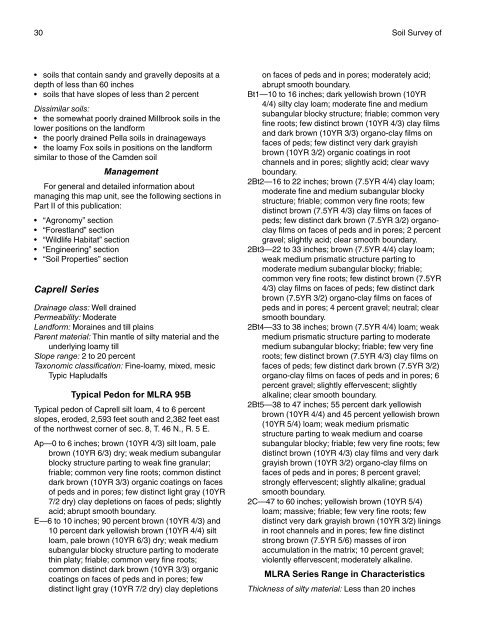Soil Survey of McHenry County, Illinois Part I - Soil Data Mart
Soil Survey of McHenry County, Illinois Part I - Soil Data Mart
Soil Survey of McHenry County, Illinois Part I - Soil Data Mart
You also want an ePaper? Increase the reach of your titles
YUMPU automatically turns print PDFs into web optimized ePapers that Google loves.
30 <strong>Soil</strong> <strong>Survey</strong> <strong>of</strong><br />
• soils that contain sandy and gravelly deposits at a<br />
depth <strong>of</strong> less than 60 inches<br />
• soils that have slopes <strong>of</strong> less than 2 percent<br />
Dissimilar soils:<br />
• the somewhat poorly drained Millbrook soils in the<br />
lower positions on the landform<br />
• the poorly drained Pella soils in drainageways<br />
• the loamy Fox soils in positions on the landform<br />
similar to those <strong>of</strong> the Camden soil<br />
Management<br />
For general and detailed information about<br />
managing this map unit, see the following sections in<br />
<strong>Part</strong> II <strong>of</strong> this publication:<br />
• “Agronomy” section<br />
• “Forestland” section<br />
• “Wildlife Habitat” section<br />
• “Engineering” section<br />
• “<strong>Soil</strong> Properties” section<br />
Caprell Series<br />
Drainage class: Well drained<br />
Permeability: Moderate<br />
Landform: Moraines and till plains<br />
Parent material: Thin mantle <strong>of</strong> silty material and the<br />
underlying loamy till<br />
Slope range: 2 to 20 percent<br />
Taxonomic classification: Fine-loamy, mixed, mesic<br />
Typic Hapludalfs<br />
Typical Pedon for MLRA 95B<br />
Typical pedon <strong>of</strong> Caprell silt loam, 4 to 6 percent<br />
slopes, eroded, 2,593 feet south and 2,382 feet east<br />
<strong>of</strong> the northwest corner <strong>of</strong> sec. 8, T. 46 N., R. 5 E.<br />
Ap—0 to 6 inches; brown (10YR 4/3) silt loam, pale<br />
brown (10YR 6/3) dry; weak medium subangular<br />
blocky structure parting to weak fine granular;<br />
friable; common very fine roots; common distinct<br />
dark brown (10YR 3/3) organic coatings on faces<br />
<strong>of</strong> peds and in pores; few distinct light gray (10YR<br />
7/2 dry) clay depletions on faces <strong>of</strong> peds; slightly<br />
acid; abrupt smooth boundary.<br />
E—6 to 10 inches; 90 percent brown (10YR 4/3) and<br />
10 percent dark yellowish brown (10YR 4/4) silt<br />
loam, pale brown (10YR 6/3) dry; weak medium<br />
subangular blocky structure parting to moderate<br />
thin platy; friable; common very fine roots;<br />
common distinct dark brown (10YR 3/3) organic<br />
coatings on faces <strong>of</strong> peds and in pores; few<br />
distinct light gray (10YR 7/2 dry) clay depletions<br />
on faces <strong>of</strong> peds and in pores; moderately acid;<br />
abrupt smooth boundary.<br />
Bt1—10 to 16 inches; dark yellowish brown (10YR<br />
4/4) silty clay loam; moderate fine and medium<br />
subangular blocky structure; friable; common very<br />
fine roots; few distinct brown (10YR 4/3) clay films<br />
and dark brown (10YR 3/3) organo-clay films on<br />
faces <strong>of</strong> peds; few distinct very dark grayish<br />
brown (10YR 3/2) organic coatings in root<br />
channels and in pores; slightly acid; clear wavy<br />
boundary.<br />
2Bt2—16 to 22 inches; brown (7.5YR 4/4) clay loam;<br />
moderate fine and medium subangular blocky<br />
structure; friable; common very fine roots; few<br />
distinct brown (7.5YR 4/3) clay films on faces <strong>of</strong><br />
peds; few distinct dark brown (7.5YR 3/2) organoclay<br />
films on faces <strong>of</strong> peds and in pores; 2 percent<br />
gravel; slightly acid; clear smooth boundary.<br />
2Bt3—22 to 33 inches; brown (7.5YR 4/4) clay loam;<br />
weak medium prismatic structure parting to<br />
moderate medium subangular blocky; friable;<br />
common very fine roots; few distinct brown (7.5YR<br />
4/3) clay films on faces <strong>of</strong> peds; few distinct dark<br />
brown (7.5YR 3/2) organo-clay films on faces <strong>of</strong><br />
peds and in pores; 4 percent gravel; neutral; clear<br />
smooth boundary.<br />
2Bt4—33 to 38 inches; brown (7.5YR 4/4) loam; weak<br />
medium prismatic structure parting to moderate<br />
medium subangular blocky; friable; few very fine<br />
roots; few distinct brown (7.5YR 4/3) clay films on<br />
faces <strong>of</strong> peds; few distinct dark brown (7.5YR 3/2)<br />
organo-clay films on faces <strong>of</strong> peds and in pores; 6<br />
percent gravel; slightly effervescent; slightly<br />
alkaline; clear smooth boundary.<br />
2Bt5—38 to 47 inches; 55 percent dark yellowish<br />
brown (10YR 4/4) and 45 percent yellowish brown<br />
(10YR 5/4) loam; weak medium prismatic<br />
structure parting to weak medium and coarse<br />
subangular blocky; friable; few very fine roots; few<br />
distinct brown (10YR 4/3) clay films and very dark<br />
grayish brown (10YR 3/2) organo-clay films on<br />
faces <strong>of</strong> peds and in pores; 8 percent gravel;<br />
strongly effervescent; slightly alkaline; gradual<br />
smooth boundary.<br />
2C—47 to 60 inches; yellowish brown (10YR 5/4)<br />
loam; massive; friable; few very fine roots; few<br />
distinct very dark grayish brown (10YR 3/2) linings<br />
in root channels and in pores; few fine distinct<br />
strong brown (7.5YR 5/6) masses <strong>of</strong> iron<br />
accumulation in the matrix; 10 percent gravel;<br />
violently effervescent; moderately alkaline.<br />
MLRA Series Range in Characteristics<br />
Thickness <strong>of</strong> silty material: Less than 20 inches

















